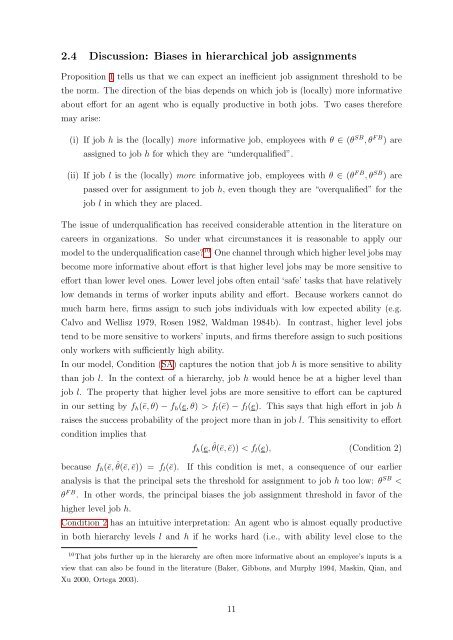Job Assignments under Moral Hazard - School of Economics and ...
Job Assignments under Moral Hazard - School of Economics and ...
Job Assignments under Moral Hazard - School of Economics and ...
Create successful ePaper yourself
Turn your PDF publications into a flip-book with our unique Google optimized e-Paper software.
2.4 Discussion: Biases in hierarchical job assignments<br />
Proposition 1 tells us that we can expect an inefficient job assignment threshold to be<br />
the norm. The direction <strong>of</strong> the bias depends on which job is (locally) more informative<br />
about effort for an agent who is equally productive in both jobs. Two cases therefore<br />
may arise:<br />
(i) If job h is the (locally) more informative job, employees with θ ∈ (θ SB , θ F B ) are<br />
assigned to job h for which they are “<strong>under</strong>qualified”.<br />
(ii) If job l is the (locally) more informative job, employees with θ ∈ (θ F B , θ SB ) are<br />
passed over for assignment to job h, even though they are “overqualified” for the<br />
job l in which they are placed.<br />
The issue <strong>of</strong> <strong>under</strong>qualification has received considerable attention in the literature on<br />
careers in organizations. So <strong>under</strong> what circumstances it is reasonable to apply our<br />
model to the <strong>under</strong>qualification case? 10 One channel through which higher level jobs may<br />
become more informative about effort is that higher level jobs may be more sensitive to<br />
effort than lower level ones. Lower level jobs <strong>of</strong>ten entail ‘safe’ tasks that have relatively<br />
low dem<strong>and</strong>s in terms <strong>of</strong> worker inputs ability <strong>and</strong> effort. Because workers cannot do<br />
much harm here, firms assign to such jobs individuals with low expected ability (e.g.<br />
Calvo <strong>and</strong> Wellisz 1979, Rosen 1982, Waldman 1984b). In contrast, higher level jobs<br />
tend to be more sensitive to workers’ inputs, <strong>and</strong> firms therefore assign to such positions<br />
only workers with sufficiently high ability.<br />
In our model, Condition (SA) captures the notion that job h is more sensitive to ability<br />
than job l. In the context <strong>of</strong> a hierarchy, job h would hence be at a higher level than<br />
job l. The property that higher level jobs are more sensitive to effort can be captured<br />
in our setting by fh(ē, θ) − fh(e, θ) > fl(ē) − fl(e). This says that high effort in job h<br />
raises the success probability <strong>of</strong> the project more than in job l. This sensitivity to effort<br />
condition implies that<br />
fh(e, ˆ θ(ē, ē)) < fl(e), (Condition 2)<br />
because fh(ē, ˆ θ(ē, ē)) = fl(ē). If this condition is met, a consequence <strong>of</strong> our earlier<br />
analysis is that the principal sets the threshold for assignment to job h too low: θ SB <<br />
θ F B . In other words, the principal biases the job assignment threshold in favor <strong>of</strong> the<br />
higher level job h.<br />
Condition 2 has an intuitive interpretation: An agent who is almost equally productive<br />
in both hierarchy levels l <strong>and</strong> h if he works hard (i.e., with ability level close to the<br />
10 That jobs further up in the hierarchy are <strong>of</strong>ten more informative about an employee’s inputs is a<br />
view that can also be found in the literature (Baker, Gibbons, <strong>and</strong> Murphy 1994, Maskin, Qian, <strong>and</strong><br />
Xu 2000, Ortega 2003).<br />
11
















